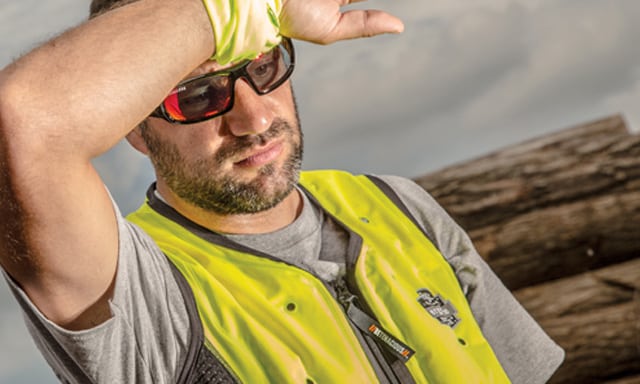
It’s imperative job site supervisors share toolbox talks on heat stress safety during periods of extreme heat.
Of course, the dangers of heat stress go well beyond the job site – to athletics, weekend recreation and everyday life. Whether at work or play, it’s important to stay cool and hydrated. Check out this heat stress safety toolbox talk.
Heat stress safety: Know the risk
Heat stress occurs when the body’s means of controlling its internal temperature starts to fail. Once the body’s temperature reaches 99.7 degrees Fahrenheit (37.6 degrees Celsius), heat stress has begun to affect the body. At 104 degrees Fahrenheit (40 degrees Celsius), it becomes susceptible to severe damage. As little as 30 minutes of 104-degree temperatures can cause cellular damage to the brain or even death.
Some workers are at greater risk of heat stress before they ever step foot in the heat due to personal factors: being older or overweight, having heart disease or high blood pressure or taking medications that act as diuretics or do not react well to extreme heat.
Environmental factors account for anything that impacts the body externally: high temperatures, direct sunlight, humidity, limited air movement, hot equipment, reflected heat from the ground, water or objects and clothing or PPE choices.
 It’s also important for you to recognize the most common heat-related illnesses:
It’s also important for you to recognize the most common heat-related illnesses:
- Heat rash: This occurs when sweat ducts become clogged and sweat can’t get to the surface of the skin.
- Heat cramps: Salt and moisture levels are depleted through excessive perspiration.
- Heat exhaustion: Prolonged exposure to high temperatures and inadequate hydration causes body temperatures to rise.
- Heat stroke: This is when the body becomes unable to control its core body temperature.
Here are some helpful ways to fight heat stress:
- Evaporative cooling: This is a simple, effective and relatively inexpensive approach that can be used in outdoor and indoor environments, but works best in drier, low-to-moderately humid conditions with sufficient airflow. Working on the same principles as how sweat cools the body, evaporative cooling solutions draw heat from workers’ bodies, using an external source of water.
- Phase change cooling: Unlike evaporative cooling technology, airflow is not required for phase change cooling, making it a prime choice for high-heat indoor settings like foundries and glass manufacturing. Solutions like phase change cooling vests use a cooling charge pack that works to pull heat away from the body.
- Absorptive cooling: Sweating occurs in order to regulate body temperature. However, too much sweat can be uncomfortable and a job site hazard, which is where absorptive technology becomes important. Materials matter when it comes to all-around comfort and performance with absorptive solutions.
These solutions help take the sting out of working in the heat.
Know when to take a break
Heat impacts people differently, so opportunities for rest should be made available to workers in hot work environments whenever needed. Ideally, access to shaded and cool areas should be conveniently located near the job site.
 Proper heat acclimation is also key. Elevated core body temperature and heart rate can occur during the first few days of working on a hot job site, when the body is strained the most. As workers become acclimated to the hot conditions, the strain decreases, and in turn, work rate improves.
Proper heat acclimation is also key. Elevated core body temperature and heart rate can occur during the first few days of working on a hot job site, when the body is strained the most. As workers become acclimated to the hot conditions, the strain decreases, and in turn, work rate improves.
The role of PPE and hydration in reducing heat stress
Employers owe it to their workers to make sure they’re equipped to handle the heat.
Federal OSHA standards don’t specifically address outdoor heat exposure and prevention of heat-related illnesses. However, Section 5(a)(1) of the General Duty Clause requires that employers provide a workplace “free from recognized hazards” that could seriously harm workers.
Workers should cover their skin to prevent sunburn, but also wear loose-fitting clothing that lets sweat evaporate, while also stopping radiant heat. This is where utilizing the evaporative cooling products mentioned above becomes important.
 Evaporative cooling products absorb water and cool more than ambient air does, helping regulate the body’s core temperature. If a job requires wearing multiple layers of PPE (turnout gear, hazmat suits, etc.), workers should use products such as cooling vests to provide much-needed cooling relief underneath or over their other protective apparel.
Evaporative cooling products absorb water and cool more than ambient air does, helping regulate the body’s core temperature. If a job requires wearing multiple layers of PPE (turnout gear, hazmat suits, etc.), workers should use products such as cooling vests to provide much-needed cooling relief underneath or over their other protective apparel.
Finally, hydration is essential. Drink water every 15 minutes to prevent dehydration.
This blog post was written in partnership with Ergodyne. Check out Ergodyne’s original articles:
- PPE’s role in reducing heat stress
- Preventing heat stress at work: Your guide to heat stress risks and solutions
Read more
Hyponatremia: The disadvantages of drinking too much water on the job site
Winter shift scheduling tools for safety supervisors (FREE DOWNLOAD)